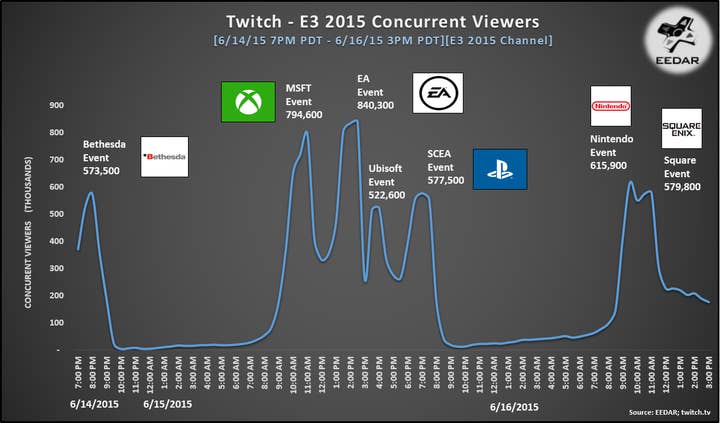Twitch analysis shows E3 schedule not maximizing viewership - EEDAR
Patrick Walker, EEDAR's VP of Insights and Analytics, examines the spikes in concurrent viewers
Earlier this week, Twitch released an infographic showing impressive growth in their E3 audience in 2015 compared to 2014. Twitch reported a peak concurrent viewership of 840,000, more than double the peak concurrent viewership of 400,000 last year. An analysis of Twitch concurrent viewers over time shows that viewership hit its peak during the second half of the EA press conference, likely during the presentation of Star Wars: Battlefront.
The graph below shows the number of concurrent viewers over the 48-hour period during which major hardware and software companies stream their press events. The seven spikes in the data correspond to the seven major press events. It is important to note that this is not a measure of overall press event viewership, as gaming enthusiasts are able to access the event through several platforms, such as the IGN website.

The Microsoft press conference had the second highest number of peak concurrent viewers after EA, reaching 796,400 viewers by the end of the event. The other press events had between 500 to 600 thousand peak concurrent viewers.
Most press events had an increase of more than 200,000 peak concurrent viewers from when the event started. This makes sense as most shows backload their event with the most anticipated games closing the show - examples include Bethesda closing with Fallout 4, Ubisoft closing with AC: Syndicate, Microsoft closing with Gears of War, and SCEA closing with Uncharted 4. Viewers that tune into see these high profile titles are unlikely to leave until they are presented.
EEDAR believes that there is a relationship between the time of day a press event is conducted and the number of streaming viewers. Previous EEDAR research into global gaming play patterns has shown that peak online gaming hours in the day occur between 11am - 2pm PDT and there is a significant dip in play between the hours of 5pm to 8pm PST. This high traffic early afternoon PDT time period was when EA hit 840,000 peak concurrent viewers. In general, the morning/afternoon press events had a higher level of viewership than the evening events. The lower viewership in the evening occurred even though the evening events were praised by the majority of the videogame press.
There are many factors that contribute to the high online traffic in the early afternoon PDT, including work, travel, and sleeping patterns across critical regions during that time window. One thing that is clear is that the importance of E3 streaming viewership is increasing rapidly. This suggests that the gaming companies may want to revisit their E3 scheduling strategy in order to optimize their total viewership.
